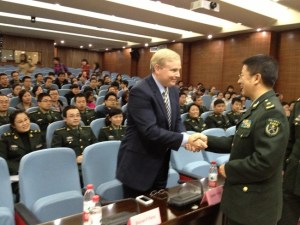By Erica Rascón on May 1, 2013 in Giving People

For Sharon Terry, CEO, establishing PXE International was not a matter of fulfilling a personal preference or a sense of adventure. The organization was created out of necessity. “We didn’t feel like we had a choice to start PXE,” she says. “We were completely compelled. If we didn’t do it, nothing would happen.”
Nearly 20 years ago, Sharon discovered that both of her young children had pseudoxanthoma elasticum (PXE), a rare genetic disease that affects the tissues of the eyes, skin, cardiovascular and gastrointestinal systems. Sharon and her husband embarked on a whirlwind study of genetics to learn more about the disease and available treatments. At that time, they had woefully limited data to help them. Inconsistencies and contradictions riddled what little information they found. The Terrys decided to take matters into their own hands, initiating PXE International. Sharon details her account in the article, Learning Genetics. “We were starting from the ground up,” recalls Sharon. “Now, we are the world’s premiere organization for PXE research.”
Since 1995, PXE International has encouraged and sponsored groundbreaking research while providing support for those affected by PXE. To date, the organization has raised more than $1.7 million for applied translational research, treatment development and product development. The organization also provides insurance advocacy for families who were previously denied coverage.
Researchers have determined that PXE is triggered by a gene that is expressed primarily in the liver; recent research has shown that PXE is a metabolic disease like diabetes or phenylketonuria. The disease can ultimately cause skin problems, vision loss, and problems in the arteries.
There is no certified treatment or cure for PXE, though recent clinical studies have made promising headway. PXE International is a collaborator in a study by Dr. Lebwohl of Mt. Sinai School of Medicine Dermatology Department. He is using high dose magnesium in an attempt to reverse the accumulation of mineral deposits in the skin, eyes and arteries, all common symptoms of PXE. The study comes from the intersection of studies in humans and mice. “When given high doses of magnesium, the disease diminished hugely [in the mice]. For some it disappeared. The hope is that this will be true in humans. While mice are good models, the treatment is not guaranteed to work the same way in humans,” says Sharon.
Yardi’s grant supports the magnesium study, which includes 44 humans. 22 participants will be given magnesium supplements; 22 participants will be given placebo. Researchers will take a biopsy of participants’ skin, examine their blood, image their hearts and bones, and photograph their eyes in five steps: participants will be studied upon initiation, six months into the magnesium treatment, then one year, 18 months, and two years into the treatment.
Another experiment on mice suggests that blood transfusions and stem cells may yield encouraging results. “A year or so ago, a lab we work with took a PXE mouse and a nonPXE mouse. They shared a blood supply for a while and the PXE went away. That told us that there is something in the blood of the healthy mouse that can get rid of PXE. There is something about the healthy liver and healthy blood that can solve this,” says Sharon.
In a separate study, healthy stem cells will be injected into a liver with PXE. If the results are consistent with in vitro testing, the healthy cells will begin to multiply, eventually overpowering and absolving the PXE cells. This approach has yet to be tested in vivo. “You can’t do a liver transplant with mice so we’re trying to find rats. That’s the first step. Then the problem is trying to put a human into the situation,” explains Sharon. “After a liver transplant, the human has to take immunosuppressant drugs for the rest of his or her life. Those drugs have horrible side effects. We have to ask which is worse, the PXE or the side effects?”
While none of these treatments have been approved in humans, all three demonstrate the major gains PXE research has made in recent history. “I’d like parents to know that there is so much more hope than there was 17 years ago,” says Sharon.
PXEers can help in the search for the cure. PXE International is currently accepting blood and tissue donations for the Biobank and Clinical Data Registry. PXEers can submit samples remotely.
Non-PXE patrons can get involved by donating towards the 15th Anniversary Challenge and by making small yet consistent donations. “Deciding to do a modest donation regularly–$5 or $10 monthly—has the largest impact for us. It’s a small sacrifice, maybe one cup of coffee per month, but that regular support is vital to us. It’s something we know that we can depend on consistently,” Sharon says.
Visit the PXE International website for more ways to get involved.


